Sing Out a Song!
-
Ships in 1 to 2 weeks
Details
Description
SKU: CF.BL1040
Composed by Mark Cabaniss. Arranged by Ruth Elaine Schram. Fold. Octavo. 12 pages. Duration 1 minute, 35 seconds. BriLee Music #BL1040. Published by BriLee Music (CF.BL1040).UPC: 680160911516. 6.875 x 10.5 inches. Key: G major. English. Original.
Sing out a Song! celebrates the gift of music and its transforming power for all who perform and hear it. By singing this song with true positive joy, it will accomplish its mission. The first vocal entrance happens soon, so be ready to jump on those notes and text with accuracy and energy. The design of having the vocals start so soon after the simple piano intro is to get the audiences full attention, as if to say Weve got a message for you! Pay careful attention to the accents on the text particularly in that opening passage, so as to help underscore the excitement of the message. The words sing out a song have two ss in them, and a little bit of s often goes a long way. Be careful to avoid too much sibilance when that phrase is sung throughout the piece. The song is rhythmic and vibrant, but when you arrive at the B-Section (beginning at m. 42), this is your chance to show a legato contrast. The rhythmic approach resumes at m. 64. Also, at m. 64, pay close attention to the contrasting dynamics for each part, written in that manner so that the melody shines as it switches quickly between Part 1 and Part 2. Of course, all singers should watch very carefully to observe the glaring rest in m. 104 so that the final, closing notes really explode with excitement and joy. In addition to offering a discussion among singers on the transforming power of music, this piece can be a springboard to highlighting the ideas of developing a positive attitude. Another message includes celebrating the differences among all people who have their own unique song to sing, while living authentically (to yourself always be true). -Mark Cabaniss.
Sing out a Song! celebrates the gift of music and its transforming power for all who perform and hear it. By singing this song with true positive joy, it will accomplish its mission. The first vocal entrance happens soon, so be ready to jump on those notes and text with accuracy and energy. The design of having the vocals start so soon after the simple piano intro is to get the audienceas full attention, as if to say aWeave got a message for you!a Pay careful attention to the accents on the text particularly in that opening passage, so as to help underscore the excitement of the message. The words asing out a songa have two sas in them, and a little bit of asa often goes a long way. Be careful to avoid too much sibilance when that phrase is sung throughout the piece. The song is rhythmic and vibrant, but when you arrive at the B-Section (beginning at m. 42), this is your chance to show a legato contrast. The rhythmic approach resumes at m. 64. Also, at m. 64, pay close attention to the contrasting dynamics for each part, written in that manner so that the melody shines as it switches quickly between Part 1 and Part 2. Of course, all singers should watch very carefully to observe the glaring rest in m. 104 so that the final, closing notes really explode with excitement and joy. In addition to offering a discussion among singers on the transforming power of music, this piece can be a springboard to highlighting the ideas of developing a positive attitude. Another message includes celebrating the differences among all people who have their own unique asonga to sing, while living authentically (ato yourself always be truea). -Mark Cabaniss.
Sing out a Song! celebrates the gift of music and its transforming power for all who perform and hear it. By singing this song with true positive joy, it will accomplish its mission. The first vocal entrance happens soon, so be ready to jump on those notes and text with accuracy and energy. The design of having the vocals start so soon after the simple piano intro is to get the audience's full attention, as if to say "We've got a message for you!" Pay careful attention to the accents on the text particularly in that opening passage, so as to help underscore the excitement of the message. The words "sing out a song" have two s's in them, and a little bit of "s" often goes a long way. Be careful to avoid too much sibilance when that phrase is sung throughout the piece. The song is rhythmic and vibrant, but when you arrive at the B-Section (beginning at m. 42), this is your chance to show a legato contrast. The rhythmic approach resumes at m. 64. Also, at m. 64, pay close attention to the contrasting dynamics for each part, written in that manner so that the melody shines as it switches quickly between Part 1 and Part 2. Of course, all singers should watch very carefully to observe the glaring rest in m. 104 so that the final, closing notes really explode with excitement and joy. In addition to offering a discussion among singers on the transforming power of music, this piece can be a springboard to highlighting the ideas of developing a positive attitude. Another message includes celebrating the differences among all people who have their own unique "song" to sing, while living authentically ("to yourself always be true"). -Mark Cabaniss.
Sing out a Song! celebrates the gift of music and its transforming power for all who perform and hear it. By singing this song with true positive joy, it will accomplish its mission. The first vocal entrance happens soon, so be ready to jump on those notes and text with accuracy and energy. The design of having the vocals start so soon after the simple piano intro is to get the audience's full attention, as if to say "We've got a message for you!" Pay careful attention to the accents on the text particularly in that opening passage, so as to help underscore the excitement of the message. The words "sing out a song" have two s's in them, and a little bit of "s" often goes a long way. Be careful to avoid too much sibilance when that phrase is sung throughout the piece. The song is rhythmic and vibrant, but when you arrive at the B-Section (beginning at m. 42), this is your chance to show a legato contrast. The rhythmic approach resumes at m. 64. Also, at m. 64, pay close attention to the contrasting dynamics for each part, written in that manner so that the melody shines as it switches quickly between Part 1 and Part 2. Of course, all singers should watch very carefully to observe the glaring rest in m. 104 so that the final, closing notes really explode with excitement and joy. In addition to offering a discussion among singers on the transforming power of music, this piece can be a springboard to highlighting the ideas of developing a positive attitude. Another message includes celebrating the differences among all people who have their own unique "song" to sing, while living authentically ("to yourself always be true"). -Mark Cabaniss.
Sing out a Song! celebrates the gift of music and its transforming power for all who perform and hear it. By singing this song with true positive joy, it will accomplish its mission.The first vocal entrance happens soon, so be ready to jump on those notes and text with accuracy and energy. The design of having the vocals start so soon after the simple piano intro is to get the audience’s full attention, as if to say “We’ve got a message for you!”Pay careful attention to the accents on the text particularly in that opening passage, so as to help underscore the excitement of the message. The words “sing out a song” have two s’s in them, and a little bit of “s” often goes a long way. Be careful to avoid too much sibilance when that phrase is sung throughout the piece.The song is rhythmic and vibrant, but when you arrive at the B-Section (beginning at m. 42), this is your chance to show a legato contrast. The rhythmic approach resumes at m. 64. Also, at m. 64, pay close attention to the contrasting dynamics for each part, written in that manner so that the melody shines as it switches quickly between Part 1 and Part 2. Of course, all singers should watch very carefully to observe the glaring rest in m. 104 so that the final, closing notes really explode with excitement and joy.In addition to offering a discussion among singers on the transforming power of music, this piece can be a springboard to highlighting the ideas of developing a positive attitude. Another message includes celebrating the differences among all people who have their own unique “song” to sing, while living authentically (“to yourself always be true”).-Mark Cabaniss.
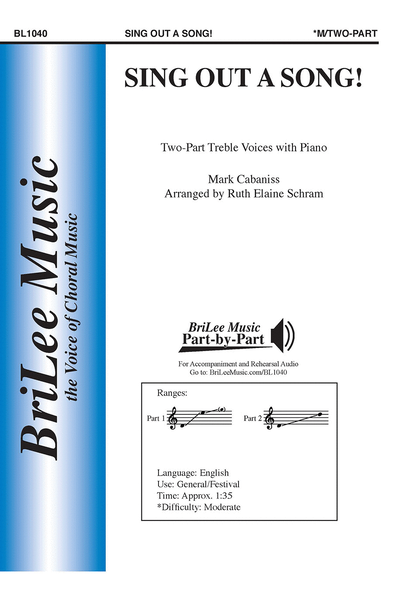
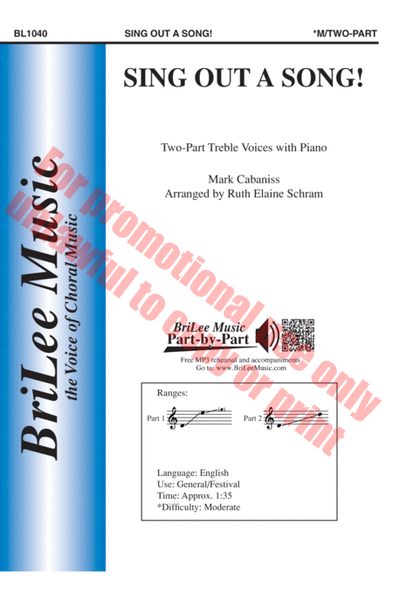
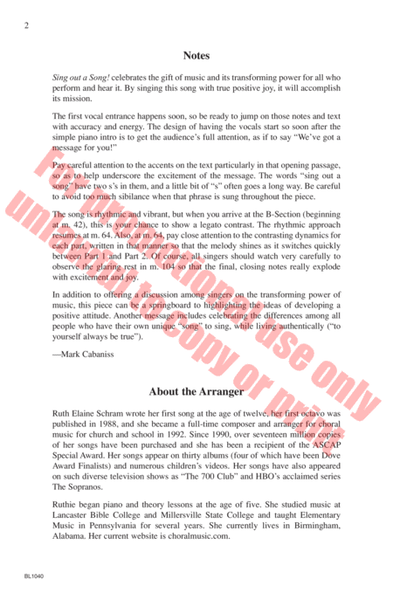
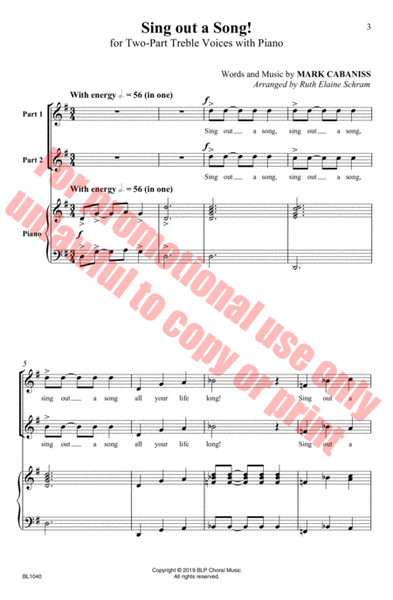
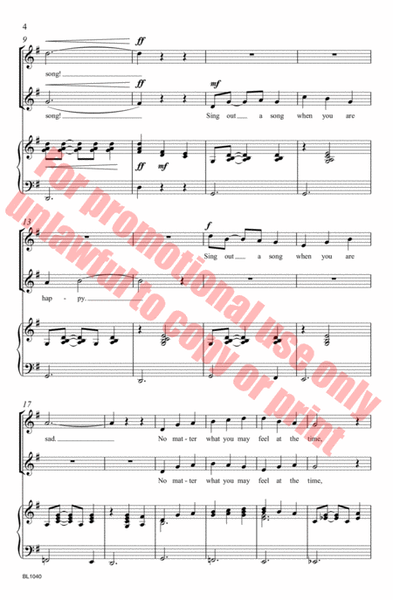
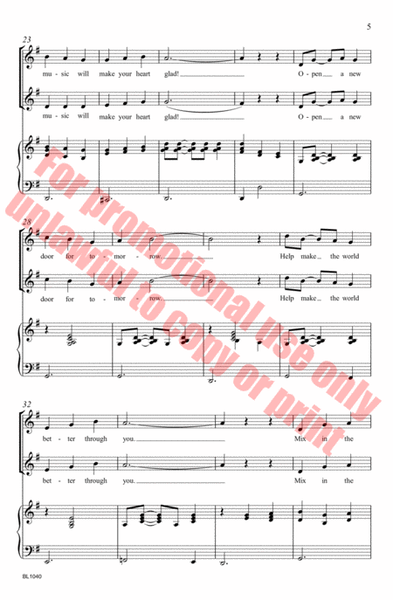
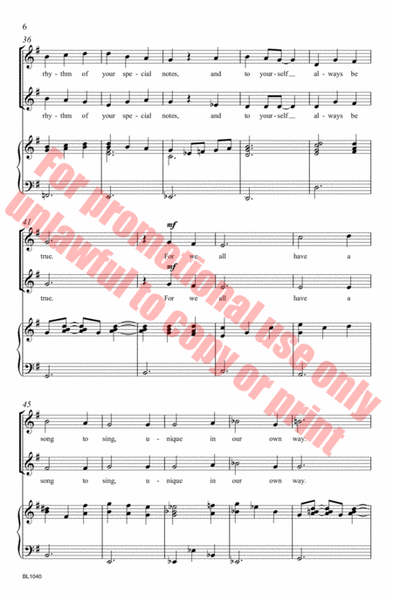

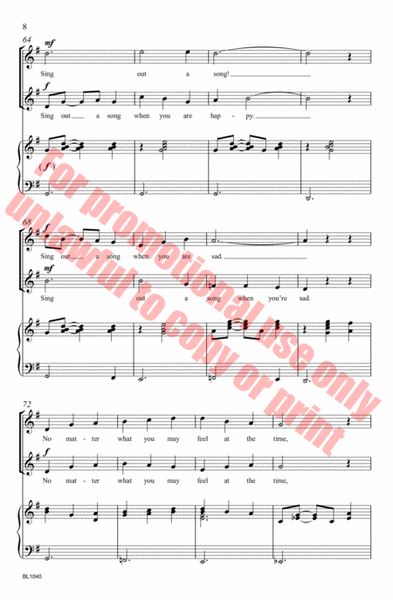
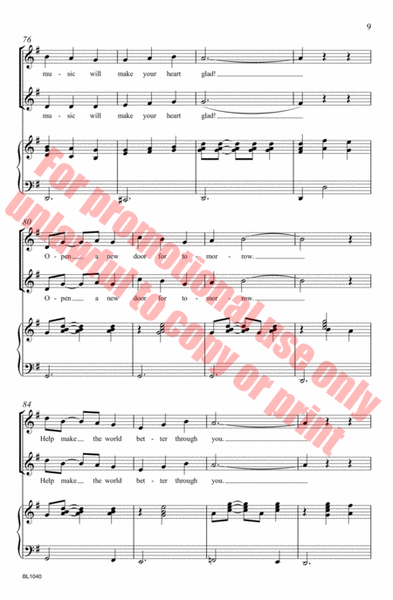
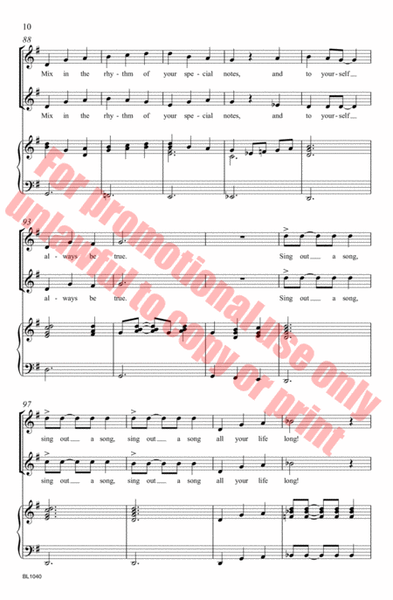
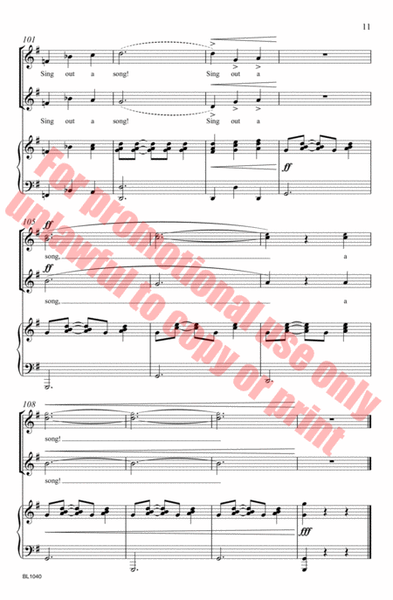
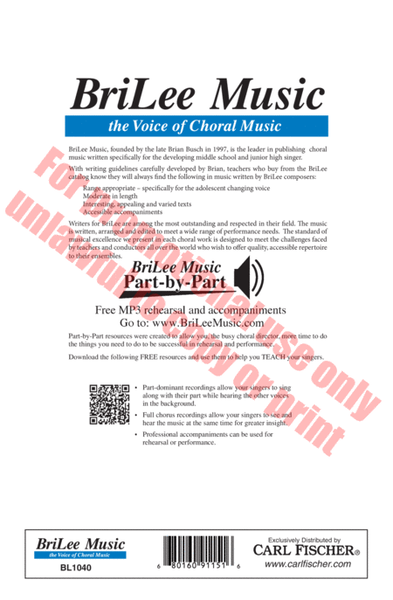
 Share
Share